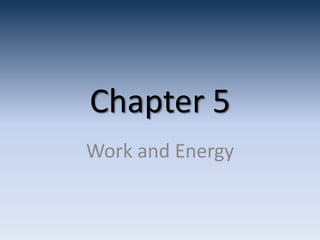Chapter 5 Work and Energy Explained
•Transferir como PPTX, PDF•
0 gostou•273 visualizações
Denunciar
Compartilhar
Denunciar
Compartilhar

Recomendados
Recomendados
Mais conteúdo relacionado
Mais procurados
Mais procurados (17)
Mais de rksteel
Mais de rksteel (20)
Chapter 5 Work and Energy Explained
- 1. Chapter 5 Work and Energy
- 2. Work • Equal to the magnitude of the force times the magnitude of the displacement (W = Fd) • Done only when the components of a force are parallel to the displacement (Figure 5-2) • Work is not done unless the object is moved
- 3. Net Work • Net work = net force x displacement x cosine of angle between them – Cosine 0 degrees = 1 – Cosine 90 degrees = 0 • Units are force times length (N x M), or joules • Three push-ups require about 1000 J
- 4. Work (cont.) • Scalar • Can be positive or negative (figure 5-3) – Dependent upon force exerted • If net work is positive, the object speeds up • If net work is negative, the object slows down